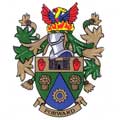
Cookstown is a town in County Tyrone, Northern Ireland. It is the fourth-largest town in the county and had a population of 12,546 in the 2021 census. It, along with Magherafelt and Dungannon, is one of the main towns in the Mid-Ulster council area. It was founded around 1620 when the townlands in the area were leased by an English ecclesiastical lawyer, Dr. Alan Cooke, from the Archbishop of Armagh, who had been granted the lands after the Flight of the Earls during the Plantation of Ulster. It was one of the main centres of the linen industry west of the River Bann, and until 1956 the flax-related processes of spinning, weaving, bleaching and beetling were carried out in the town.

The Ulster Transport Authority (UTA) ran rail and bus transport in Northern Ireland that operated from 1948 until 1967.

The Northern Counties Committee (NCC) was a railway that served the north-east of Ireland. It was built to Irish gauge but later acquired a number of 914 mm narrow gauge lines. It had its origins in the Belfast and Ballymena Railway which opened to traffic on 11 April 1848.

York Road railway station served the north of Belfast in Northern Ireland. It was formerly one of the three terminus railway stations in Belfast. The others were Great Victoria Street, and Queen's Quay.
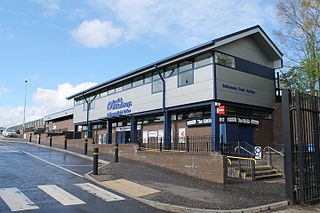
Ballymena railway station serves the town of Ballymena in County Antrim, Northern Ireland. It is located just outside Ballymena town centre on the Galgorm Road, and is integrated with the local bus station. It is situated on the Derry line between Antrim and Cullybackey. The station is operated by Northern Ireland Railways.

The M22 is a motorway in County Antrim, Northern Ireland. It is 5.6 miles (9 km) long and connects the A6 with the M2. It forms part of the unsigned European route E16.

The A6 road in Northern Ireland runs for 71.4 miles (114.9 km) from Belfast to Derry, via County Antrim and County Londonderry. While stretches of the road before Randalstown have now been superseded by a motorway, the A6 remains one of the most important arterial routes in Northern Ireland, connecting its two largest cities and urban areas. Between Randalstown and Derry, the road forms part of European route E16.
The Black Mountain transmitting station is a broadcasting and telecommunications facility, situated on Black Mountain to the west of the city of Belfast, on land 301 metres (988 ft) above Ordnance Datum in Northern Ireland. It includes a guyed steel lattice mast which is 228.6 metres (750 ft) in height. The height of the top of the structure above mean sea level is 529 metres (1,736 ft). It is owned and operated by Arqiva.

Randalstown is a townland and small town in County Antrim, Northern Ireland, between Antrim and Toome. It has a very prominent disused railway viaduct and lies beside Lough Neagh and the Shane's Castle estate. The town is bypassed by the M22 motorway with junctions at both the eastern and western ends of the town. It had a population of 5,151 people in the 2021 census.

Templepatrick railway station served the village of Templepatrick in County Antrim on the Belfast-Derry railway line.
Castledawson railway station was on the Belfast and Ballymena Railway Cookstown branch line, which ran from Cookstown Junction to Cookstown in Northern Ireland.
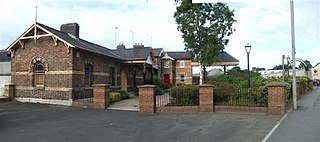
Cookstown railway station was one of two railway stations serving the town of Cookstown in County Tyrone, Northern Ireland.
Magherafelt railway station was on the Belfast and Ballymena Railway which ran from Cookstown Junction to Cookstown in Northern Ireland.
Moneymore railway station in Moneymore, County Londonderry, was on an extension of the Belfast and Ballymena Railway which ran from Cookstown Junction in County Antrim to Cookstown in County Tyrone in Northern Ireland.
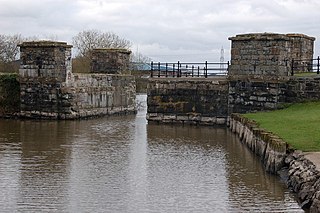
Toome Bridge railway station was on the Belfast and Ballymena Railway's Cookstown branch line, which ran from Cookstown Junction to Cookstown in Northern Ireland. Located in Toome in County Antrim on the River Bann with County Londonderry across the river.
Staffordstown railway station was on the Belfast and Ballymena Railway which ran from Cookstown Junction to Cookstown in Northern Ireland.

Cookstown Junction railway station served the townland of Drumsough outside Randalstown in County Antrim, Northern Ireland. It was a single island platform at the junction of the Cookstown extension to Magherafelt, Cookstown, Draperstown and Macfin.
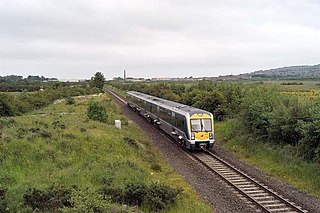
Ballyclare Junction railway station was on the Belfast and Ballymena Railway which ran from Belfast to Ballymena in Northern Ireland. Despite the name, the physical junction for the branch line to Ballyclare was located a short distance along the line in the Antrim direction, at Kingsbog Junction.
Whitehouse railway station was on the Belfast and Ballymena Railway which ran from Belfast to Ballymena in Northern Ireland.

Cookstown railway station was one of the two stations serving Cookstown in County Tyrone in Northern Ireland.















